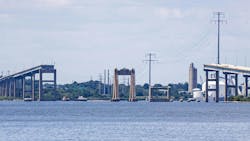How Baltimore carriers endured the bridge collapse, port closure
After Baltimore’s Francis Scott Key Bridge collapsed, local carriers faced an existential threat. Swift collaboration between government and industry helped fleets adjust their operations to the sudden loss of a vital river crossing.
“There was such a great response from the Coast Guard and the various agencies involved in clearing the channel and getting the port reopened,” Louis Campion, president and CEO of the Maryland Motor Truck Association, told FleetOwner this week. “It was something that went much, much faster than I think anyone anticipated at the time of the bridge strike.”
Swift cleanup efforts, regulatory waivers, and grant funding helped local carriers maintain their operations. However, troubles remain for these carriers today. Severe congestion still disrupts travel times, and labor disputes threaten to shut down the port again.
Rapid recovery, river cleanup
The scale of Baltimore’s bridge collapse
Baltimore’s Francis Scott Key Bridge was a major traffic route and crossed one of the busiest shipping routes in the nation. Before the collapse, vehicles crossing the Key Bridge amounted to 11 million annually. Roughly 4,900 trucks crossed the bridge each day.
After a container ship struck the bridge on March 26, it destroyed the bridge and halted all maritime traffic to the Port of Baltimore. Several major distribution centers and warehouses lost their primary traffic route. Shipments to the port were diverted to other East Coast ports.
The port’s limited operations lost roughly $191 million in economic activity every day.
When the Francis Scott Key Bridge collapsed, vessel channels to the Port of Baltimore were essentially blockaded. Agencies swiftly cleared the shipping channel of debris within just three months. The state fully reopened the Port of Baltimore in June.
Maryland postponed the demolition of some remaining parts of the bridge to spring 2025, but the state’s transportation authority is already making plans for a new, stronger, and taller bridge to span the Patapsco River.
The port’s ship traffic has mostly returned, and local freight demand around the port has similarly recovered. Countless new economic variables make it difficult to compare freight volumes to before the collapse, but Campion estimates that demand recovered by about 85-90% so far.
“Clearly it has been a robust recovery,” Campion said. “Not 100% but certainly back.”
Waivers and funding helped keep local fleets afloat
Government assistance was a key lifeline for Baltimore-area businesses.
“The expected impacts when the bridge first collapsed were minimized by virtue of a lot of cooperation between government and industry,” Campion said.
Local fleets needed to take alternative, longer routes to adjust for the bridge collapse. Several months of Baltimore-destined freight was redirected across the East Coast ports. Many short-haul drivers near the port needed to cross state lines for the first time. For these operations, local fleets would normally need to adjust drivers’ hours of service, implement ELD compliance, acquire International Registration Plan registration, and use International Tuel Tax Agreement decals.
Government agencies were quick to respond to the issue and MMTA’s petitions. The Federal Motor Carrier Safety Administration allowed a short-haul ELD exception and adjusted drivers’ time limits, the Maryland Motor Vehicle Administration implemented an IRP waiver for carriers, and the Maryland Comptroller issued a waiver for IFTA requirements.
Several streams of financial assistance also supported local businesses. The Small Business Administration offered low-interest, long-term loans of up to $2 million. Various grant programs from state agencies offered direct funding to local businesses.
How fleets are faring
Disruptions immediately after the collapse threatened to shut down local carriers. MMTA members endured the challenge.
In April, Campion spoke with one MMTA member who ran between 10 and 20 trucks. “The first comment out of the owner’s mouth was: ‘I’m trying to make sure that I still have a business in three weeks,’” Campion told FleetOwner in April.
Fortunately, the carrier survived the ordeal.
“That business is still alive and kicking, which is great,” Campion said. In fact, Campion was not aware of any association members in intermodal port trucking who shuttered due to the bridge collapse.
Though carriers survived the disaster’s immediate impacts, their trials are far from over.
Congestion challenges remain
Congestion in the area is still troubled. Baltimore-area drivers face sporadic congestion and extended rush-hour periods. The disrupted traffic makes carriers’ delivery and route timings more unpredictable.
“Travel times have increased, in some cases very significantly, but it’s also very inconsistent from a day-to-day and route-to-route standpoint,” Campion said. “And so that makes it really difficult to plan.”
In September, average travel times along major routes increased by 42% to as much as 217% year over year, according to the Baltimore Metropolitan Council. Campion said that he has seen 15-minute routes now take 30 minutes, and 30-minute routes now take two hours.
Until the state constructs a new bridge, a significant amount of traffic uses three alternative routes: the Fort McHenry Tunnel, the Baltimore Harbor Tunnel, and the Baltimore Beltway.
“Those are overwhelmingly the most impacted routes,” Campion said.
Another port strike threatens carriers
Baltimore area fleets are not free of port closures yet. Four months after reopening, East Coast port strikes again shut the port down for three days—and that labor dispute, which halted operations in October, is unresolved.
A massive strike across several East Coast ports forced the port to close in October. The strike ended after an agreement between the disputing parties—the International Longshoremen’s Association and the United States Maritime Alliance—kicked the issue down to January 15.
Both parties face difficult negotiations around automation and wages, and a longer strike is more likely in January. The labor conflict could significantly disrupt freight movement along the East Coast.
See also: Threat of ‘calamitous’ port strike awaits trucking in January
“The first strike was a huge concern, and this one an equal concern,” Campion told FleetOwner. “Those, on top of the experience with the Key Bridge collapse, as great as the response was ... there are only so many things that a company can take. A second strike would certainly have a huge detrimental impact.”
About the Author
Jeremy Wolfe
Editor
Editor Jeremy Wolfe joined the FleetOwner team in February 2024. He graduated from the University of Wisconsin-Stevens Point with majors in English and Philosophy. He previously served as Editor for Endeavor Business Media's Water Group publications.

